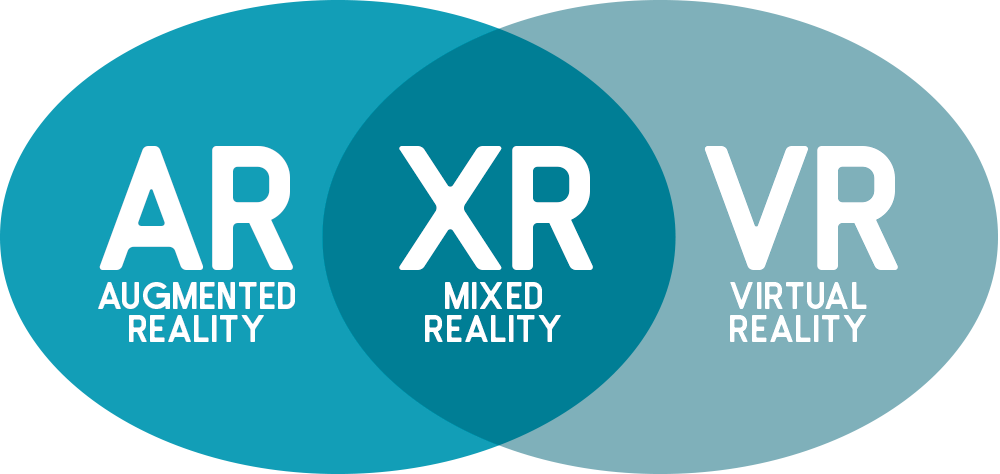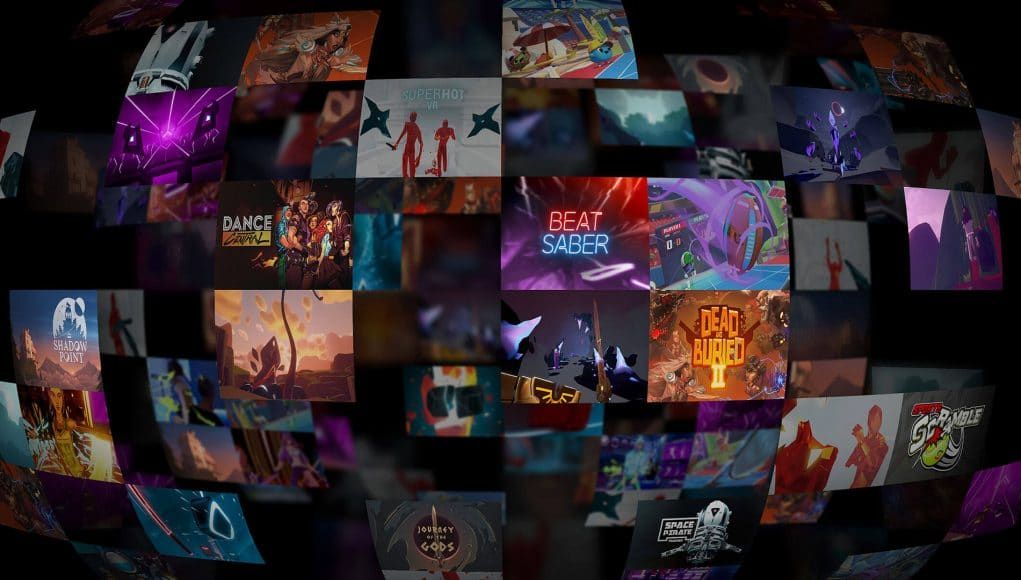LEARN


What is augmented reality (AR) ?
Augmented reality (AR) is the superposition of reality and elements (sounds, 2D, 3D images, videos, etc.) calculated by a computer system in real time. It often refers to the different methods that allow realistically embed virtual objects in a sequence of images.
These applications are numerous and affect more and more fields, such as video games, education through games, virtual treasure hunts, cinema and television (post-production, virtual studios, sports broadcasts, etc.), industries (conception, design, maintenance, assembly, piloting, robotics and telerobotics, implantation, impact study, etc.) or the medical field.
Augmented reality is one of the emerging phenomena enabled by the development and democratization of information and communication technologies (ICT).

What is Virtual Reality (VR) ?
Virtual reality (VR) is a computer technology that simulates the physical presence of a user in an environment artificially generated by software. Virtual reality creates an environment with which the user can interact. Virtual reality therefore artificially reproduces a sensory experience, which can include sight, touch, hearing and smell (visual, sound or haptic).
The purpose of virtual reality is to allow a person (or several) to live an experience of immersion or not, that is to say to carry out a sensorimotor and cognitive activity in a digitally created world, which can be “imaginary, symbolic or a simulation of certain aspects of the real world” (extract from the Treaty of virtual reality, P. Fuchs).
Source: Wikipedia
Context of convergence of revolutions:
If AR and VR are entering a new era today, it is above all because 4 major elements converge to make this revolution possible:
– new uses : over the past ten years, consumers have become accustomed to many new technologies that are entering their daily lives at high speed.
Like the presentation of Steeve Job for the iPhone, consumers very quickly adopted new devices (headsets, smartphones, connected glasses, etc.), such as new applications.
Today, hardly anyone goes out without their smartphone, which has become the digital extension of every individual.
We are lost when we find ourselves without, to the point of returning to retrieve it …
– new structural means (4G / 5G) which allow ever faster data transmission.
The major issue that has harmed the use of Devices for a very long time is the ability to exchange data between a computer and a headset via an internet connection. Not only have wifi technologies evolved (notably with the advent of Wifi 6, which has exploded throughput and range).
In addition, the 4G network infrastructure and soon 5G allows data / smartphone / other devices transmission anywhere with increasingly impressive quality and accessibility.
– new devices / democratization of products / equipment rate
Devices are also evolving very quickly. Whether it is smartphones which today all integrate (in any case the most recent) the capabilities of broadcasting AR in particular, connected glasses like the HOLOLENS which make strong AR interactions possible or even VR headsets and in particular the OCULUS QUEST which allows you to live these experiences wirelessly and without a pc or console.
These strengths are the biggest drivers of the explosion in uses. Given these developments, the equipment rate is exploding (with growth of more than 100% this year in sales of VR headsets, and the explosion in demand for oculus quest (the only relevant wireless offer on the market) .
At Digital Mate, we are convinced that 2020 will be the advent of the democratization of these products which will massively enter all homes and all businesses.
– new software :
All smartphones today have a software layer that complements the “augmented and virtual ecosystem”. (AR and VR kits for iOS and Android).
In addition, the development of technologies such as Cloud Gaming deport the software layer to remote infrastructures making possible a depth of service never seen remotely.
A market with colossal potential
The AR and VR market has been slow to emerge. Long considered a future El Dorado, time had almost ended up destroying this idea of visual revolution. But that was without counting the convergence of the factors we have just deciphered and the disruptions of innovations such as wireless headphones, the cloud and data transmission speeds in particular. All of this has already made the democratization of these technologies possible.
By 2020, the augmented reality and virtual reality market will represent more than $ 100 billion worldwide.
VR headset sales in 2019 grew more than 100% from 2018 (mainly driven by year-end sales of the Oculus Quest)
The latest sales figures in France revealed by an idate study:
• 2018: 200,000
• 2019: around 400,000
Projections predict a considerable acceleration in the equipment rate
• 2020: 540,000
• 2021: 790,000
• 2022: 1.1 Million
• 2023: 1.46 Million (The outlook for 2023 worldwide is 42 Million!)
At Digital Mate, we are counting on an even faster democratization, in particular with the advent of autonomous headsets and handtracking
The markets that open are those of the general public in an entertainment / games / discovery logic
Besides this, a colossal market for companies will develop more and more.
All industries will be affected by AR and VR with operational, technical, commercial, entertainment uses …
Nielsen’s Superdata figures speak volumes about the boom in these markets.
Even if virtual reality is presented as predominant in the coming years, we are betting more on a short-term explosion of augmented reality and mixed reality.
Virtual reality, which is much more immersive, will undoubtedly take a little longer to arrive in our permanent daily uses, unlike augmented reality which will invade our days.
Small Panorama of possibilities in video :
The different uses of AR and VR :
The objective here is to give a non-exhaustive but fairly comprehensive list of the possibilities offered by augmented reality and virtual reality, in each field, for each type of activity.
Augmented reality:
Education: Additional content for books (videos, interactivity)
Medical: Learning, popularization of certain organs and their functioning, their positioning in the body. Names of bones etc.
Music: Mobile application with augmented reality to present a new album (Jean-Louis Aubert), street marketing operations with holograms or posters in augmented reality, additional content such as clips or explanations
Advertising: The universe to explore is huge and obviously extremely interesting for advertisers who will see an opportunity to advertise differently:
– Interactive advertising inserts
– Product visualization, with the possibility of changing color, size, etc.
– Interactive product packaging
-…
Leisure / Fun:
Immersion in a partially real setting.
Interactivity with the visitor / spectator
Video games.
Transport:
Augmented navigation
Points of interest
Traffic information
Industrial:
– product life cycle
– design
– training
– sizing
Heritage / Tourism: Additional content during the visit of a museum, of buildings, visualization of the life of the period, reconstruction of the initial monuments, visualization of changes over time
– Label scan
– interactive product catalogs, unlimited depth of range
– Brand attractiveness
– Additional product information
– Viewing products at home, in the right place
Police: Surveillance system, personal information, facial recognition …
Publishing / Written press: Interactive content, animations, additional information, etc.
Don’t have enough examples? Come on, we’re going on a hyperreality trip 😉
Virtual reality :
Communication:
– videoconference through avatars
– Hologrammes, mixed reality, deep fake, ia :
Education / Training:
– E-learning at home, in private session
– environment simulation, manipulation, rotation and assembly of objects,
– medical / military: training on simulations of living beings: without consequence
Architecture:
– Modeling of environments, 3D buildings, interior navigation, exterior views, modifications.
-> allows customers / users to project themselves into the environments
Video games :
– 3D immersions
– Shoot them up VR
– Navigation, puzzle game
– Movements, reflexes (dance, beatific saber like, etc.)
– Sport, fighting
…
And a whole bunch of areas, such as art, virtual storytelling, remote product fitting, museum visits, astrophysics, etc.
Conclusion
As we have seen, the possibilities as well as the markets are immense.
We are going to witness a considerable revolution in our modes of consumption, representation, learning, etc.
These AR / VR technologies are young and therefore perfectible.
There are still limits to be exceeded:
– motion sickness (nausea effect when using VR) for some users
– data flow transfer speed to improve
– perfectible textures and display
– catalog of content to be developed
– imagination for uses
– sometimes still high cost
– equipment rate
But it’s a safe bet that many of these brakes / limits will be overcome quickly.
Either way, we are facing an immediate revolution.
The perception of individuals, their look at reality will be completely upset.
The possibilities are immense.
These technologies at the service of learning, communication, escape, emotion, entertainment will find pride of place in what we already know.
They will not necessarily replace our traditional uses like television did not kill books. But for sure, augmented reality, like virtual reality, will be the daily life of our businesses, our homes, and more broadly of our everyday life.
What to review our notion of what will be the reality of tomorrow!
Sources : Wikipedia, https://www.digitalmate.fr/, YouTube, Koreus, Etude iDate, SuperData Nielsen compa
